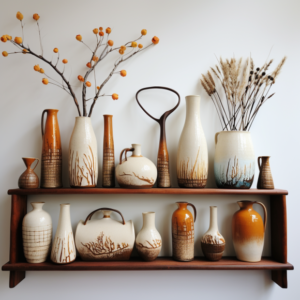Ce
ramics have played a significant role in the history of art, influencing and intersecting with various artistic movements throughout time. In this blog post, we will explore the connections between ceramics and art history, highlighting the ways in which ceramic techniques, aesthetics, and concepts have shaped and been shaped by different artistic movements.
- Ancient Ceramics: The origins of ceramics can be traced back to ancient civilizations, where pottery served utilitarian purposes. The artistry and craftsmanship of ancient ceramic vessels, sculptures, and tiles laid the foundation for future developments in ceramics. Ancient ceramics influenced art movements through their use of form, decoration, and cultural symbolism.
- Renaissance Influence: During the Renaissance, ceramics experienced a revival as artists sought inspiration from classical antiquity. The interest in ancient Greek and Roman pottery led to the development of majolica, a type of tin-glazed earthenware. Renaissance artists incorporated ceramics into their artistic practices, creating decorative objects and architectural elements that reflected the period’s fascination with beauty, proportion, and humanism.
- Art Nouveau: In the late 19th and early 20th centuries, the Art Nouveau movement embraced organic forms and natural motifs, finding inspiration in the flowing lines and delicate details of ceramics. Artists such as Émile Gallé and René Lalique utilized ceramics to create intricate and whimsical designs that embodied the essence of Art Nouveau. Ceramic tiles and architectural elements also became integral to the movement’s decorative aesthetics.
- Bauhaus and Modernism: The Bauhaus movement, founded in the early 20th century, embraced the principles of functionality, simplicity, and mass production. Ceramic artists at the Bauhaus, such as Otto Lindig and Theodor Bogler, explored innovative techniques and minimalist designs that aligned with the movement’s vision. The focus on form and utility in Bauhaus ceramics influenced the development of modernist design and the concept of “less is more.”
- Abstract Expressionism: In the mid-20th century, abstract expressionism emerged as a revolutionary movement in the art world. Ceramic artists like Peter Voulkos and Ruth Duckworth challenged traditional notions of ceramics by experimenting with abstract forms and gestural techniques. Their innovative approach to ceramics reflected the spontaneity and expressive freedom of abstract expressionism.
- Postmodernism: In the late 20th century, ceramics became an integral part of the postmodernist movement, which sought to deconstruct and challenge established conventions. Ceramic artists like Judy Chicago and Grayson Perry used ceramics to explore issues of identity, gender, and cultural commentary. They pushed the boundaries of ceramics as a medium, incorporating mixed media, unconventional forms, and provocative imagery.
- Contemporary Ceramic Sculpture: Contemporary ceramic sculpture continues to push the boundaries of the medium, blurring the lines between ceramics and sculpture. Artists such as Ai Weiwei and Betty Woodman have created monumental ceramic installations that challenge traditional notions of ceramics and expand the possibilities of the art form. Ceramic sculpture today embraces conceptual ideas, narrative storytelling, and a diverse range of materials and techniques.
Conclusion: Ceramics have had a profound impact on the history of art, influencing and being influenced by various artistic movements. From ancient civilizations to the contemporary art scene, ceramics have played a vital role in shaping artistic expression and pushing the boundaries of the medium. Whether through form, technique, or conceptual exploration, ceramics have continued to inspire and captivate artists throughout history, leaving an indelible mark on the world of art.



